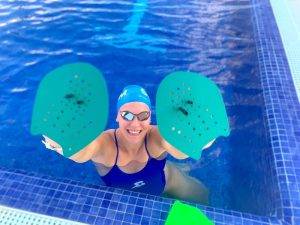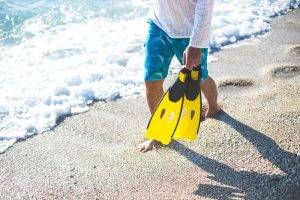Swimming, a sport celebrated for its grace and athleticism, immerses athletes in a world where precision and efficiency reign. Behind the sleek strokes and streamlined movements, an array of swimming equipment plays a crucial role in enhancing performance, ensuring safety, and contributing to the overall swimming experience. In this in-depth exploration, we plunge into the depths of swimming equipment, unraveling the nuances of gear that range from essentials like swimsuits and goggles to specialized tools designed to refine technique and optimize training.
Essential Swimming Gear: The Foundations
Swimwear
Racing Swimsuits:
Designed for competitive swimmers, racing swimsuits are sleek, form-fitting, and crafted from hydrophobic materials. These suits minimize drag, enhance buoyancy, and are tailored to optimize speed and efficiency in the water.
Training Swimsuits:
For everyday training sessions, swimmers often opt for durable training swimsuits. These suits balance comfort with functionality and are typically made from chlorine-resistant fabrics to withstand the rigors of regular pool use.
Swim Caps
Silicone Caps:
Silicone swim caps are popular for their durability, elasticity, and snug fit. They effectively streamline the swimmer’s head, reducing drag in the water. Silicone caps are commonly used in both training and competitive settings.
Latex Caps:
Latex swim caps provide a lightweight and budget-friendly alternative. While less durable than silicone, latex caps are comfortable and suitable for regular training sessions.
Goggles
Racing Goggles:
Similar to racing swimsuits, racing goggles are designed for competitive swimmers. They feature low-profile designs, anti-fog coatings, and snug seals to provide clear vision and minimal drag.
Training Goggles:
Training goggles prioritize comfort and durability. They often have larger frames, adjustable straps, and additional cushioning around the eyes for extended use during practice sessions.
Specialized Training Equipment: Refining Technique
Swim Fins
Short Fins:
Short fins, or training fins, help swimmers build leg strength and improve kicking technique. They are ideal for various drills and can be used by swimmers of all levels to enhance propulsion.
Long Fins:
Long fins, with extended blades, focus on building power and endurance. They are often utilized in specialized training to target specific muscle groups and refine kicking techniques.
Pull Buoys
Leg Isolation:
Pull buoys are flotation devices placed between the legs to isolate the upper body during swim workouts. By immobilizing the legs, swimmers can concentrate on improving arm strength, pull technique, and overall upper body conditioning.
Kickboards
Leg Strengthening:
Kickboards are essential tools for isolating and strengthening the leg muscles. Swimmers hold onto the board while kicking, allowing for focused leg workouts that enhance propulsion and improve kicking technique.
Hand Paddles
Stroke Enhancement:
Hand paddles are worn on the hands to increase resistance and surface area during strokes. They aid in improving arm strength, enhancing stroke technique, and promoting better catch and pull phases.
Competitive Swimming Accessories
Tech Suits
Advanced Racing Technology:
Tech suits, or technical racing suits, represent the pinnacle of swimwear technology. These suits are engineered with advanced materials and compression technology to optimize buoyancy, reduce drag, and enhance performance during competitive races.
Nose Clips and Ear Plugs
Water Protection:
Nose clips and ear plugs are used by swimmers to prevent water entry into the nasal passages and ears. They are particularly helpful in minimizing the risk of ear infections and sinus issues caused by prolonged exposure to water.
Safety Gear: Prioritizing Well-Being
Life Jackets and Floatation Devices
Learn-to-Swim Tools:
For beginners and individuals learning to swim, life jackets and floatation devices provide added buoyancy and support. These safety tools instill confidence and are commonly used in swimming lessons.
Rescue Tubes and Lifeguard Equipment
Emergency Preparedness:
In a lifeguarding or competitive swimming setting, rescue tubes and other lifeguard equipment are essential for ensuring the safety of swimmers. These tools aid in swift rescue operations and emergency response.
Maximizing Comfort: Additional Accessories
Swim Towels
Quick-Drying Towels:
Swimmers often use quick-drying towels to dry off quickly after exiting the pool. These towels are designed to absorb moisture efficiently and are compact for easy storage in swim bags.
Swim Backpacks
Gear Organization:
Swim backpacks are specifically designed to accommodate swim gear. They feature waterproof compartments, mesh pockets, and multiple storage areas to keep swim equipment organized and easily accessible.
Water Bottles and Hydration Packs
Stay Hydrated:
Staying hydrated is crucial for swimmers. Water bottles and hydration packs are essential accessories to have poolside, providing convenient access to fluids during training sessions.
Cutting-Edge Technology: Swim Watches and Trackers
Swim Watches
Performance Monitoring:
Swim watches are equipped with features such as lap counting, stroke tracking, and distance measurement. They allow swimmers to monitor their performance, set goals, and track progress over time.
Swim Trackers
Stroke Analysis:
Advanced swim trackers go beyond basic metrics, offering detailed stroke analysis, efficiency metrics, and real-time feedback. These devices contribute to refining technique and optimizing training regimens.
Choosing the Right Equipment: Considerations and Recommendations
Skill Level
Beginner Swimmers:
For beginners, focus on essential gear such as swimsuits, goggles, and swim caps. Gradually introduce training equipment as skills develop.
Intermediate and Advanced Swimmers:
Intermediate and advanced swimmers can benefit from specialized training equipment to refine technique, enhance strength, and optimize performance.
Training Goals
Technique Improvement:
Swimmers aiming to improve specific aspects of their technique may incorporate hand paddles, pull buoys, and fins into their training routines.
Endurance and Strength:
For those focused on building endurance and strength, long fins, kickboards, and resistance devices like swim parachutes can be valuable additions.
Competitive Swimmers
Tech Suits:
Competitive swimmers may explore advanced racing technology with tech suits for key competitions. These suits are designed for optimal performance in high-stakes races.
Swim Watches and Trackers:
Swimmers looking to track and analyze their performance can invest in swim watches and trackers to gain insights into their strokes, lap times, and overall efficiency.
Cost Considerations: Budget-Friendly Alternatives
Affordable Swimsuit Options
Training Swimsuits:
Opt for budget-friendly training swimsuits made from durable materials. These suits offer comfort and functionality without the premium price tag.
Basic Swim Accessories
Latex Caps and Standard Goggles:
Basic swim accessories like latex caps and standard goggles are cost-effective options that provide essential functionality for swimmers.
Alternatives to Specialized Equipment
Improvised Training Tools:
Swimmers on a budget can improvise training tools using household items. For instance, plastic bottles filled with water can serve as makeshift hand weights for resistance training.
Related Post:
Unraveling the Tempo: How Long is a Volleyball Game?
Demystifying the Drama: How Does the NBA Playoffs Work?
The Unsung Hero: Unveiling the Role of the Fullback in Soccer
As swimmers embark on their aquatic journeys, the significance of well-chosen swimming equipment becomes evident. From the sleek racing suits that glide through the water to the specialized training tools that refine technique, each piece of gear contributes to the holistic swimming experience.
Whether you’re a novice learning the basics, an intermediate swimmer refining your strokes, or a competitive athlete seeking that extra edge, the world of swimming equipment offers a diverse array of options. As you navigate the waters, remember that the right gear not only enhances performance but also ensures safety, comfort, and a deeper appreciation for the artistry of swimming. So, dive in, explore the possibilities, and let the currents of progress carry you to new heights in the pool.



